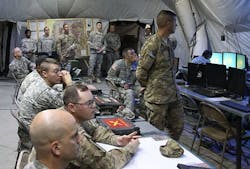Two companies continue Air Force research in military communications and battlefield intelligence
Officials of the Air Force Research Laboratory at Wright-Patterson Air Force Base, Ohio, have announced a $75 million increase in the Air Force Research Lab's Human Interface Research and Technology (HIRT) program, which the two contractors will share over the next three years.
The companies receiving the research increase are Infoscitex Corp. in Littleton, Mass.; and Ball Aerospace & Technologies Corp. in Boulder, Colo. The companies will continue pursuing research involved in enhancing battle management through machine automation, sensors, and situational awareness.
Specifically, Infoscitex and Ball Aerospace experts will provide additional research in the discovery, development, and delivery of revolutionary cognitive engineering, team decision making, human perception, performance, and cognitive technologies to deliver persistent situation awareness and improved warfighter decision making for synchronized Air Force operations in air, space, and cyberspace.
Related: Military research budget headed up for third straight year; largest seen in past five years
The Air Force's Human Interface Research and Technology program revolves around research in battlespace acoustics, battlespace visualization, supervisory control and cognition, applied neuroscience, and aerospace physiology.
Battlespace acoustics seeks to develop advanced auditory displays and interface systems to optimize human performance and communication. Battlespace vision seeks to enhance human visual reasoning with information fusion and information visualization.
Supervisory control and cognition seeks to improve human interaction with automation and visualizations. Applied neuroscience focuses on the human's ability to sense and judge adequate levels of knowledge and understanding necessary to make effective decisions on the battlefield.
Aerospace physiology, meanwhile, focuses on the ability to evaluate human/machine interfaces developed for military ground, air, and space operations. Infoscitex and Ball Aerospace will compete for separate research orders over the next three years.
Related: Army Research Lab approaches industry for cyber security project that targets cyber defense
The HIRT program is part of the Air Force Science and Technology Plan, which emphasizes four areas: autonomous systems, human performance augmentation, robust situational awareness, and reduced cyber vulnerabilities. The goal is to develop better ways for warfighters to gather information, report information, control systems, and issue orders.
On this contract Infoscitex and Ball Aerospace will do the work in Dayton, Ohio and at Wright-Patterson Air Force Base, Ohio, and should be finished by May 2020.
For more information contact Infoscitex online at www.infoscitex.com, Ball Aerospace at www.ball.com/aerospace, or the Air Force Research Lab at www.wpafb.af.mil/afrl.
Learn more: search the Aerospace & Defense Buyer's Guide for companies, new products, press releases, and videos

